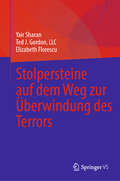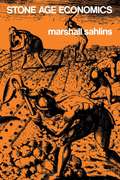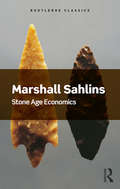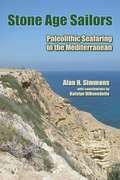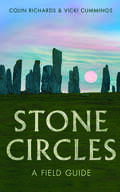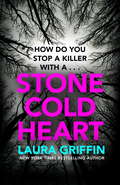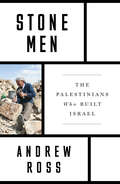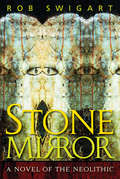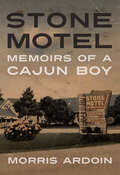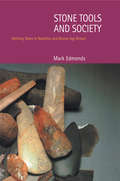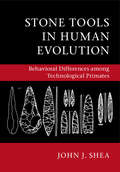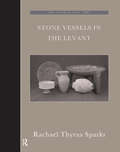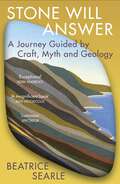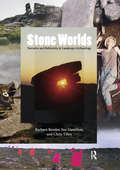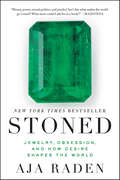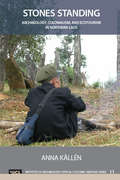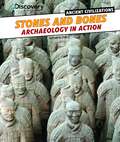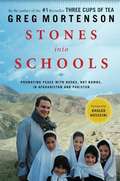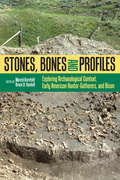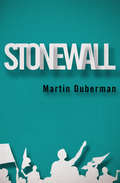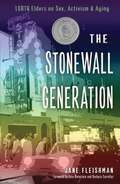- Table View
- List View
Stolpersteine auf dem Weg zur Überwindung des Terrors
by Yair Sharan Elizabeth Florescu Ted J. Gordon, LLCIn diesem Buch werden die potenziellen Entwicklungen des Terrorismus und die Möglichkeiten diesen zu verhindern, bewertet. Das Buch thematisiert die wachsende Bedrohung durch die Verfügbarkeit neuer Technologien und wie diese dazu beitragen können, diejenigen mit potenziell böswillige Absichten aufzuhalten. Der Donnerhall des Terrors ertönt von überall her; wie können wir ihn aufhalten? Was sind die Stolpersteine auf dem Weg dorthin und wie können wir sie vermeiden? Immer mehr Menschen haben Zugang zu immer mehr Informationen und immer mehr zerstörerischen Technologien. Inzwischen helfen uns fortschrittliche Technologien, eine sicherere und harmonischere Welt zu schaffen. Vorteile und Nachteile verstärken sich gegenseitig. Während die hybriden Bedrohungen zunehmen, steigen auch die Möglichkeiten, ihnen zu begegnen. Doch was sind die Kompromisse und wie können wir sie abmildern? Dieses Buch befasst sich auch mit den unerwarteten und oft zufälligen Erfolgen und Misserfolgen von Maßnahmen zur Bekämpfung der sich entwickelnden Terrorgefahr. Die verschiedenen Aspekte des Terrorismusphänomens werden auf einzigartige Weise anhand von Szenarien dargestellt, die dem Leser ein realistisches Bild von der Bedrohung vermitteln. Die Kombination positiver und negativer Auswirkungen aufkommender Technologien beschreibt eine der vielleicht wichtigsten Dimensionen unserer gemeinsamen Zukunft.
Stone Age Economics
by Marshall SahlinsAmbitiously tackling the nature of economic life and how to study it comparatively, the book includes six studies which reflect the author's ideas on revising traditional views of the hunter-gatherer and so-called primitive societies, revealing them to be the original affluent society. The book examines notions of production, distribution and exchange in early communities and examines the link between economics and cultural and social factors. It consists of a set of detailed and closely related studies of tribal economies, of domestic production for livelihood, and of the submission of domestic production to the material and political demands of society at large.
Stone Age Economics (Routledge Classics)
by Marshall SahlinsSince its first publication over forty years ago Marshall Sahlins's Stone Age Economics has established itself as a classic of modern anthropology and arguably one of the founding works of anthropological economics. Ambitiously tackling the nature of economic life and how to study it comparatively, Sahlins radically revises traditional views of the hunter-gatherer and so-called primitive societies, revealing them to be the original "affluent society." Sahlins examines notions of production, distribution and exchange in early communities and examines the link between economics and cultural and social factors. A radical study of tribal economies, domestic production for livelihood, and of the submission of domestic production to the material and political demands of society at large, Stone Age Economics regards the economy as a category of culture rather than behaviour, in a class with politics and religion rather than rationality or prudence. Sahlins concludes, controversially, that the experiences of those living in subsistence economies may actually have been better, healthier and more fulfilled than the millions enjoying the affluence and luxury afforded by the economics of modern industrialisation and agriculture. This Routledge Classics edition includes a new foreword by David Graeber, London School of Economics.
Stone Age Sailors: Paleolithic Seafaring in the Mediterranean
by Alan H SimmonsOver the past decade, evidence has been mounting that our ancestors developed skills to sail across large bodies of water early in prehistory. In this fascinating volume, Alan Simmons summarizes and synthesizes the evidence for prehistoric seafaring and island habitation worldwide, then focuses on the Mediterranean. Recent work in Melos, Crete, and elsewhere-- as well as Simmons’ own work in Cyprus-- demonstrate that long-distance sailing is a common Paleolithic phenomenon. His comprehensive presentation of the key evidence and findings will be of interest to both those interested in prehistory and those interested in ancient seafaring.
Stone Circles: A Field Guide
by Colin Richards Vicki CummingsThe definitive guide to the stone circles of Britain and Ireland From Stonehenge and the Ring of Brogdar to the Rollright Stones and Avebury, the British and Irish Isles are scattered with the stone circles of our prehistoric ancestors. Although there have been many theories to explain them, to this day there is no consensus about their purpose. Colin Richards and Vicki Cummings provide a clear and illuminating field guide to 424 key stone circle sites in Britain and Ireland. Organised by region, this handy volume sets out the features of these megalithic monuments, including their landscape position, construction, and physical properties. The authors take stock of cutting-edge research and recent excavations stone circles that were previously lost to time. They present new insights on the chronology, composition, and roles of different circles to transform our understanding the sites. Beautifully illustrated with photographs, maps, and plans, this is an essential guide to Britain and Ireland&’s most mysterious prehistoric monuments.
Stone Cold Heart: The thrilling new Tracers novel
by Laura GriffinWith her signature breathless pacing and suspenseful twists and turns, Stone Cold Heart demonstrates why 'Laura Griffin never fails to put me on the edge of my seat' (USA TODAY).The New York Times bestselling author 'delivers another top-notch thriller' (RT Book Reviews) in her beloved Tracers series, about a leading forensic anthropologist who uncovers eerie clues in a high-stakes case that threatens to deliver her to the doorstep of a cold-blooded murderer. Perfect for fans of Karen Rose, Alexandra Ivy and Kendra Elliot.When local rock climbers stumble upon abandoned human bones in a remote Texas gorge, Sara Lockhart is the first to get the call. She has a reputation as one of the nation's top forensic anthropologists, and police detective Nolan Hess knows she is just the expert he needs to help unravel this case. Although evidence is scarce, Nolan suspects the bones belong to a teenage climber who vanished last summer.But as Sara unearths strange clues, she finds chilling similarities to a case from her past - a case that now threatens to rock Nolan's community. While Sara digs deep for answers, the stakes rise higher as another young woman disappears without a trace. Investigators work against the clock as Sara races to discover the truth, even if her harrowing search brings her face to face with a stone-cold killer.Raves for Laura Griffin:'Desperate Girls is a nail-biting read from the very first page to the final, shocking twist. I could not put this book down' Melinda Leigh'Griffin pulls out all the stops in a phenomenal twist ending that will leave readers stunned' Publishers Weekly
Stone Men: The Palestinians Who Built Israel
by Andrew RossThe Story of Palestine's Stonemasons and the Building of Israel"They demolish our houses while we build theirs." This is how a Palestinian stonemason, in line at a checkpoint outside a Jerusalem suburb, described his life to Andrew Ross. Palestinian "stone men", utilizing some of the best quality dolomitic limestone deposits in the world and drawing on generations of artisanal knowledge, have built almost every state in the Middle East except their own. Today the business of quarrying, cutting, fabrication, and dressing is Palestine's largest employer and generator of revenue, supplying the construction industry in Israel, along with other Middle East countries and even more overseas.Drawing on hundreds of interviews in Palestine and Israel, Ross's engrossing, surprising, and gracefully written story of this fascinating, ancient trade shows how the stones of Palestine, and Palestinian labor, have been used to build out the state of Israel--in the process, constructing "facts on the ground"--even while the industry is central to Palestinians' own efforts to erect bulwarks against the Occupation. For decades, the hands that built Israel's houses, schools, offices, bridges, and even its separation barriers have been Palestinian. Looking at the Palestine-Israel conflict in a new light, this book asks how this record of achievement and labor can be recognized.
Stone Mirror: A Novel of the Neolithic
by Rob SwigartA Turkish farmer finds a large obsidian mirror on top of a mound. How did it get there? What did it mean for its creator, and what does it mean for us? In this teaching novel by writer Rob Swigart, the story toggles back and forth between a Neolithic village—and the changing fortunes of the family who finds this wondrous tool—and modern archaeologists whose excavated treasure stirs journalists, governments, and goddess worshippers alike. Through an engrossing tale across millennia, Swigart’s novel provides both a basic reconstruction of Neolithic lifeways and a primer on contemporary archaeological politics and practice. For archaeology students, and for anyone curious about artifacts past and present, Stone Mirror will be a fun, informative introduction both to archaeology and to the people they study.
Stone Motel: Memoirs of a Cajun Boy (Willie Morris Books in Memoir and Biography)
by Morris ArdoinIn the summers of the early 1970s, Morris Ardoin and his siblings helped run their family's roadside motel in a hot, buggy, bayou town in Cajun Louisiana. The stifling, sticky heat inspired them to find creative ways to stay cool and out of trouble. When they were not doing their chores—handling a colorful cast of customers, scrubbing motel-room toilets, plucking chicken bones and used condoms from under the beds—they played canasta, an old ladies’ game that provided them with a refuge from the sun and helped them avoid their violent, troubled father. Morris was successful at occupying his time with his siblings and the children of families staying in the motel’s kitchenette apartments but was not so successful at keeping clear of his father, a man unable to shake the horrors he had experienced as a child and, later, as a soldier. The preteen would learn as he matured that his father had reserved his most ferocious attacks for him because of an inability to accept a gay or, to his mind, broken, son. It became his dad’s mission to “fix” his son, and Morris’s mission to resist—and survive intact. He was aided in his struggle immeasurably by the love and encouragement of a selfless and generous grandmother, who provides his story with much of its warmth, wisdom, and humor. There’s also suspense, awkward romance, naughty French lessons, and an insider’s take on a truly remarkable, not-yet-homogenized pocket of American culture.
Stone Tools & Society: Working Stone In Neolithic And Bronze Age Britain
by Mark EdmondsStone tools are the most durable and, in some cases, the only category of material evidence that students of prehistory have at their disposal. Exploring the changing character and context of stone tools in Neolithic and Bronze Age Britain, Mark Edmonds examines the varied ways in which these artefacts were caught up in the fabric of past social life. Key themes include:stone tool procurement and production * the nature of technological traditions * stone tools and social identity * the nature of exchange and the significance of depositional practices. As well as contributing to current debate about the interpretation of material culture, Dr. Edmonds uses the evidence of stone tools to reconsider some of the major horizons of change in later British prehistory.From the production of tools at spectacularly located quarries to their ceremonial burial or destruction at ritual monuments, this well-illustrated study demonstrates that our understanding of these varied and sometimes enigmatic artefacts requires a concern with their social, as well as their practical dimensions.
Stone Tools in Human Evolution
by John J. SheaIn Stone Tools in Human Evolution, John J. Shea argues that over the last three million years hominins' technological strategies shifted from occasional tool use, much like that seen among living non-human primates, to a uniquely human pattern of obligatory tool use. Examining how the lithic archaeological record changed over the course of human evolution, he compares tool use by living humans and non-human primates and predicts how the archaeological stone tool evidence should have changed as distinctively human behaviors evolved. Those behaviors include using cutting tools, logistical mobility (carrying things), language and symbolic artifacts, geographic dispersal and diaspora, and residential sedentism (living in the same place for prolonged periods). Shea then tests those predictions by analyzing the archaeological lithic record from 6,500 years ago to 3. 5 million years ago.
Stone Tools in the Paleolithic and Neolithic Near East
by John J. SheaStone Tools in the Paleolithic and Neolithic Near East: A Guide surveys the lithic record for the East Mediterranean Levant (Lebanon, Syria, Israel, Jordan, and adjacent territories) from the earliest times to 6,500 years ago. It is intended both as an introduction to this lithic evidence for students and as a resource for researchers working with Paleolithic and Neolithic stone tool evidence. Written by a lithic analyst and professional flintknapper, this book systematically examines variation in technology, typology, and industries for the Lower, Middle, and Upper Paleolithic; the Epipaleolithic; and Neolithic periods in the Near East. It is extensively illustrated with drawings of stone tools. In addition to surveying the lithic evidence, the book also considers ways in which archaeological treatment of this evidence could be changed to make it more relevant to major issues in human origins research. A final chapter shows how change in stone tool designs point to increasing human dependence on stone tools across the long sweep of Stone Age prehistory.
Stone Vessels in the Levant (The Palestine Exploration Fund Annual)
by RachaelThyrza SparksExamining stone vessels in the Levant during the 2nd millennium BC, the author explores the links between material culture and society through a comprehensive study of production and distribution. Extensively illustrated with 100 drawings, maps and charts, this volume includes a full object catalogue.This study represents the first comprehensive overview of the stone vessel assemblagesof the Levant in this period, a time which, fed by an increase of wealth and interregional trade, saw a growth in the popularity and variety of such vessels.Previously, our understanding of the varied functions and forms of these diverse vessels has been relatively underdeveloped. In this volume the author attempts to address this problem by creating a typological framework though which we can analyse variability and define essential characteristics of local stone vessel workshops. Only once this has been achieved is it possible to look at stone vessel production in its wider cultural context. Subsequent chapters explore broader themes, beginning within the workshops themselves, examining the links between craftsmen, their sources of raw materials, and the authorities that controlled and distributed their output. Considerations of the geographical and chronological distribution of such goods are then used to provide a regional perspective for the operation of these workshops, connections between them, and further insights into the nature of local and international trade. Finally, the objects themselves can be used to assess the impact of trends such as the growing Egyptianization of the ruling classes of the Levant at this time.
Stone Will Answer: A Journey Guided by Craft, Myth and Geology
by Beatrice SearleA beautiful memoir, travelogue and meditation on stone by artist and stone mason Beatrice Searle.'Extraordinary' Guardian‘A magnificent book’ Alex Woodcock‘Exceptional’ Kerri Andrews‘Luminous’ SpectatorAt the age of twenty-six, artist and Cathedral stonemason Beatrice Searle crossed the North Sea and walked 500 miles along a medieval pilgrim path through Southern Norway, taking with her a 40-kilogram Orcadian stone.Fascinated with the mysterious footprint stones of Northern Europe and the ancient Greco-Roman world, stones closely associated with travellers, saints and the inauguration of Kings, she follows in their footsteps as her stone becomes a talisman, a bedrock and an offering to those she meets along the way.Stone Will Answer is an unusual adventure story of journeys practical, spiritual and geological, of weight and motion, and an insight into a beguiling craft.
Stone Worlds: Narrative and Reflexivity in Landscape Archaeology (University College London Institute Of Archaeology Publications)
by Sue Hamilton Barbara Bender Christopher TilleyThis book represents an innovative experiment in presenting the results of a large-scale, multidisciplinary archaeological project. The well-known authors and their team examined the Neolithic and Bronze Age landscapes on Bodmin Moor of Southwest England, especially the site of Leskernick. The result is a multivocal, multidisciplinary telling of the stories of Bodmin Moor—both ancient and modern—using a large number of literary genres and academic disciplines. Dialogue, storytelling, poetry, photo essays and museum exhibits all appear in the volume, along with contributions from archaeologists, anthropologists, sociologists, geologists, and ecologists. The result is a major synthesis of the Bronze Age settlements and ritual sites of the Moor, contextualized within the Bronze Ages of southwestern and central Britain, and a tracing of the changing meaning of this landscape over the past five thousand years. Of obvious interest to those in British prehistory, this is a substantial presentation of a groundbreaking project that will also be of interest to many concerned with the interpretation of social landscapes and the public presentation of archaeology.
Stone: Stories of Urban Materiality
by Tim EdensorIn undertaking a systematic analysis of urban materiality, this book investigates one kind of material in Melbourne: stone. The work draws on a range of pertinent, current theories that consider materiality, assemblages, networks, phenomenology, resource and extraction geographies, memorialisation, maintenance and repair, place identity, skill, sensation and affect, haunting and the vitalism of the non-human. In appealing to the general reader, academics and students, this book provides a highly readable account, replete with evocative examples and fascinating historical and contemporary stories about stone in Melbourne.
Stoned: Jewelry, Obsession, and How Desire Shapes the World
by Aja RadenAs entertaining as it is incisive, Stoned is a raucous journey through the history of human desire for what is rare, and therefore precious.What makes a stone a jewel? What makes a jewel priceless? And why do we covet beautiful things? In this brilliant account of how eight jewels shaped the course of history, jeweler and scientist Aja Raden tells an original and often startling story about our unshakeable addiction to beauty and the darker side of human desire.What moves the world is what moves each of us: desire. Jewelry—which has long served as a stand-in for wealth and power, glamor and success—has birthed cultural movements, launched political dynasties, and started wars. Masterfully weaving together pop science and history, Stoned breaks history into three categories—Want, Take, and Have—and explains what the diamond on your finger has to do with the GI Bill, why green-tinted jewelry has been exalted by so many cultures, why the glass beads that bought Manhattan for the Dutch were initially considered a fair trade, and how the French Revolution started over a coveted necklace.Studded with lively personalities and fascinating details, Stoned tells the remarkable story of our abiding desire for the rare and extraordinary.
Stonehenge - A New Understanding: Solving The Mysteries Of The Greatest Stone Age Monument
by Mike Parker Pearson“The most authoritative, important book on Stonehenge to date.”—Kirkus, starred review Stonehenge stands as an enduring link to our prehistoric ancestors, yet the secrets it has guarded for thousands of years have long eluded us. Until now, the millions of enthusiasts who flock to the iconic site have made do with mere speculation—about Stonehenge’s celestial significance, human sacrifice, and even aliens and druids. One would think that the numerous research expeditions at Stonehenge had left no stone unturned. Yet, before the Stonehenge Riverside Project—a hugely ambitious, seven-year dig by today’s top archaeologists—all previous digs combined had only investigated a fraction of the monument, and many records from those earlier expeditions are either inaccurate or incomplete. Stonehenge—A New Understanding rewrites the story. From 2003 to 2009, author Mike Parker Pearson led the Stonehenge Riverside Project, the most comprehensive excavation ever conducted around Stonehenge. The project unearthed a wealth of fresh evidence that had gone untouched since prehistory. Parker Pearson uses that evidence to present a paradigm-shifting theory of the true significance that Stonehenge held for its builders—and mines his field notes to give you a you-are-there view of the dirt, drama, and thrilling discoveries of this history-changing archaeological dig.
Stones Standing: Archaeology, Colonialism, and Ecotourism in Northern Laos (UCL Institute of Archaeology Critical Cultural Heritage Series)
by Anna KällénThis book is an inquiry into the relationships between archaeology, colonialism and ecotourism at the famous standing stones of Hintang, Laos. It investigates the conditions under which archaeological knowledge has been produced, appropriated, contested, commodified, and consumed by colonialism from the 1930s until today and what it shows about the power dynamics of heritage and ecotourism. The volume-explores how the discourses of colonialism and ecotourism affect tourists, archaeologists, heritage managers, and the local community;-is written as a set of overlapping creative essays, each giving an overlapping perspective on Hintang;-is a multidisciplinary research project based on ethnographic fieldwork, archival research, interviews with community members, biography, material culture studies, and text analysis.
Stones and Bones: Archaeology in Action (Discovery Education: Ancient Civilizations)
by Kathryn SteeleDiscusses the work of archaeologists and describes the sites and artifacts they work with, including such things as ancient cities and burial grounds, temples, sunken ships, tools, and writing tablets.
Stones into Schools: Promoting Peace with Books, Not Bombs, in Afghanistan and Pakistan
by Greg MortensonThe author of the #1 bestseller "Three Cups of Tea" offers the continuing story of this determined humanitarian's efforts to promote peace through education. Filled with rich, personal stories and insights into the Middle East, this book is an inspiration--and a call to action. (Proofreader's Note: There are a handful of map pages. I included all the verbal data on the maps. Photo descriptions included and checked. For large print readers or others who use it, the index was also carefully proofread and corrected as needed.)
Stones, Bones, and Profiles: Exploring Archaeological Context, Early American Hunter-Gatherers, and Bison
by Marcel Kornfeld Bruce B. HuckellStones, Bones, and Profiles addresses key and cutting-edge research of three pillars of hunter-gatherer archaeology. Stones and bones—flaked stone tools and the bones of the prey animals—are the objects most commonly recovered from hunter-gatherer archaeological sites, and profiles represent the geologic context of the archeological record. Together they constitute the foundations of much of early archaeology, from the appearance of the earliest humans to the advent of the Neolithic. The volume is divided into three sections: Peopling of North America and Paleoindians, Geoarchaeology, and Bison Bone Bed Studies. The first section dissects established theories about the Paleoindians, including the possibility that human populations were in North America before Clovis and the timing of the opening of the Alberta Corridor. The second section provides new perspectives on the age and contexts of several well-known New World localities such as the Lindenmeier Folsom and the UP Mammoth sites, as well as a synthesis of the geoarchaeology of the Rocky Mountains' Bighorn region that addresses significant new data and summarizes decades of investigation. The final section, Bison Bone Bed Studies, consists of groundbreaking zooarchaeological studies offering new perspectives on bison taxonomy and procurement. Stones, Bones, and Profiles presents new data on Paleoindian archaeology and reconsiders previous sites and perspectives, culminating in a thought-provoking and challenging contribution to the ongoing study of Paleoindians around the world. Contributors: Leland Bement, Jack W. Brink, John Carpenter, Brian Carter, Thomas J. Connolly, Linda Scott Cummings, Loren G. Davis, Allen Denoyer, Stuart J. Fiedel, Judson Byrd Finley, Andrea Freeman, C. Vance Haynes Jr., Bryan Hockett, Vance T. Holliday, Dennis L. Jenkins, Thomas A. Jennings, Eileen Johnson, George T. Jones, Oleksandra Krotova, Patrick J. Lewis, Vitaliy Logvynenko, Ian Luthe, Katelyn McDonough, Lance McNees, Fred L. Nials, Patrick W. O’Grady, Mary M. Prasciunas, Karl J. Reinhard, Michael Rondeau, Guadalupe Sanchez, William E. Scoggin, Ashley M. Smallwood, Iryna Snizhko, Thomas W. Stafford Jr., Mark E. Swisher, Frances White, Eske Willerslev, Robert M. Yohe II, Chad Yost
Stonewall
by Martin DubermanA powerful firsthand account of the Stonewall riots and the birth of the modern gay rights movement<P> "We, the people, declare today that the most evident of truths--that all of us are created equal--is the star that guides us still, just as it guided our forebears through Seneca Falls, and Selma, and Stonewall." --President Obama, 2013 Inaugural Address <P> In the summer of 1969, the Stonewall Inn, one of the few places where gay men could gather, was a mafia-run unlicensed bar in New York City's Greenwich Village. An unforeseen raid on the night of June 28 by federal agents ignited the now-famous five days of Stonewall riots that kindled the nation's gay rights movement. Expertly weaving personal, eyewitness accounts of the riots, Martin Duberman's Stonewall is an engrossing look at how six individuals, from distinctly different backgrounds, helped bring political and social awakening to the gay liberation movement.
Stonewall Generation: LGBTQ Elders on Sex, Activism, and Aging
by Jane Fleishman“It deserves prominent placement on LGBTQ history bookshelves. . . . An indelible collection of wise voices resonating with experience, pride, resilience, and revolution.” —Kirkus starred review Foreword by Kate Bornstein and Barbara Carrellas In The Stonewall Generation: LGBTQ Elders on Sex, Activism, and Aging, sexuality researcher Jane Fleishman shares the stories of fearless elders in the LGBTQ community who came of age around the time of the Stonewall Riots of 1969. In candid interviews, they lay bare their struggles, strengths, activism, and sexual liberation in the context of the political movements of the 1960s and 1970s and today. Each of these inspiring figures has spent a lifetime fighting for the right to live, love, and be free, facing challenges arising from their sexual orientation, gender, race, ethnicity, religion, politics, disabilities, kinkiness, non-monogamy, and other identities. These are the stories of those whose lives were changed forever by Stonewall and who in turn became agents of change themselves. A sex-positive and unapologetic depiction of LGBTQ culture and identity, The Stonewall Generation includes the voices of those frequently marginalized in mainstream tellings of LGBTQ history, lifting up the voices of people of color, transgender people, bisexual people, drag queens, and sex workers. We need to hear these voices, particularly at a time when our country is in the middle of a crisis that puts hard-won civil and human rights at risk, values we’ve fought for again and again in our nation’s history. For anyone committed to intersectional activism and social justice, The Stonewall Generation provides a much-needed resource for empowerment, education, and renewal.
Stonewall kommt in die Jahre: Eine feministisch-anerkennungstheoretische Studie zum gelingenden Alter(n) queerer Menschen (Vallendarer Schriften der Pflegewissenschaft #15)
by Kathrin KürstenIm Rahmen dieses Buches wird erforscht, inwiefern sich das Alter(n) von queeren Menschen von dem der heteronormativen Mehrheit unterscheidet und wie ein gelingendes Alter(n) dieser spezifischen Minderheitengruppe gewährleistet werden kann. Die mittels themenzentrierter Interviews erhobenen und anhand einer qualitativen Inhaltsanalyse interpretierten Daten werden vor dem theoretischen Hintergrund der Anerkennungstheorie (Honneth), dem Queer-Feminismus (Butler) und dem Minderheitenstressmodell (Meyer) diskutiert. Zum Abschluss erfolgt eine Proposition einer Theorie zum gelingenden Alter(n) queerer Menschen, die neben einer inhaltlichen Auseinandersetzung auch praktische Empfehlungen für den pflegerischen Alltag anbietet.
